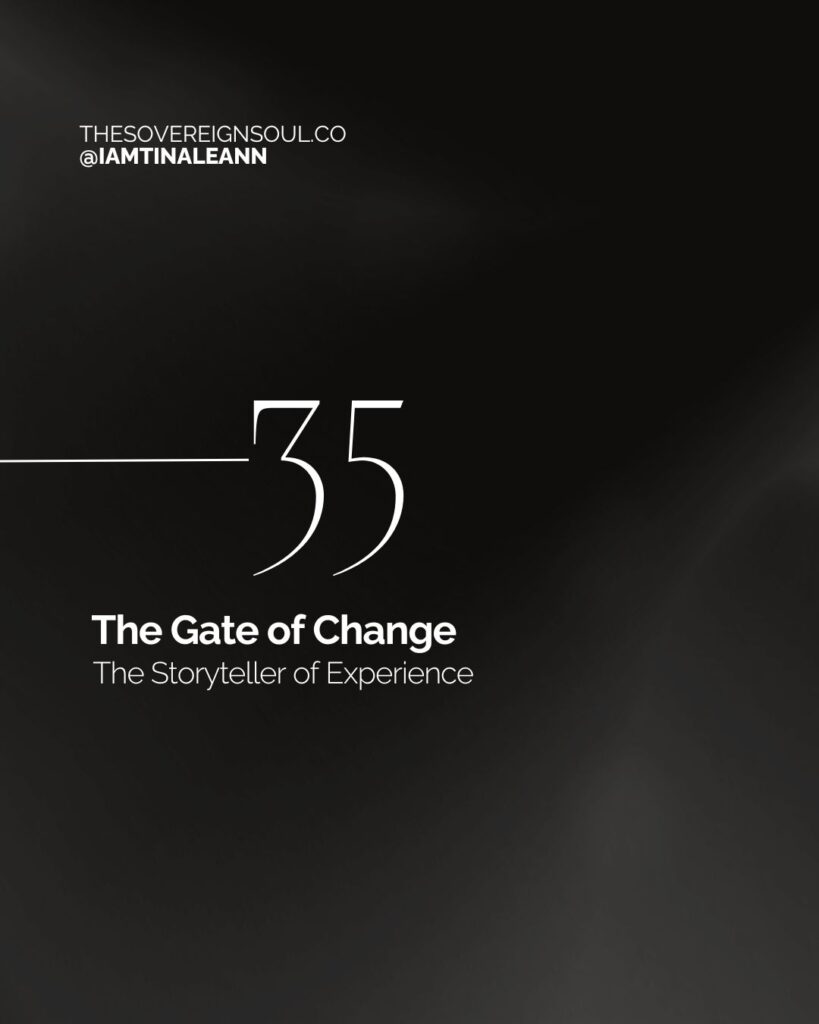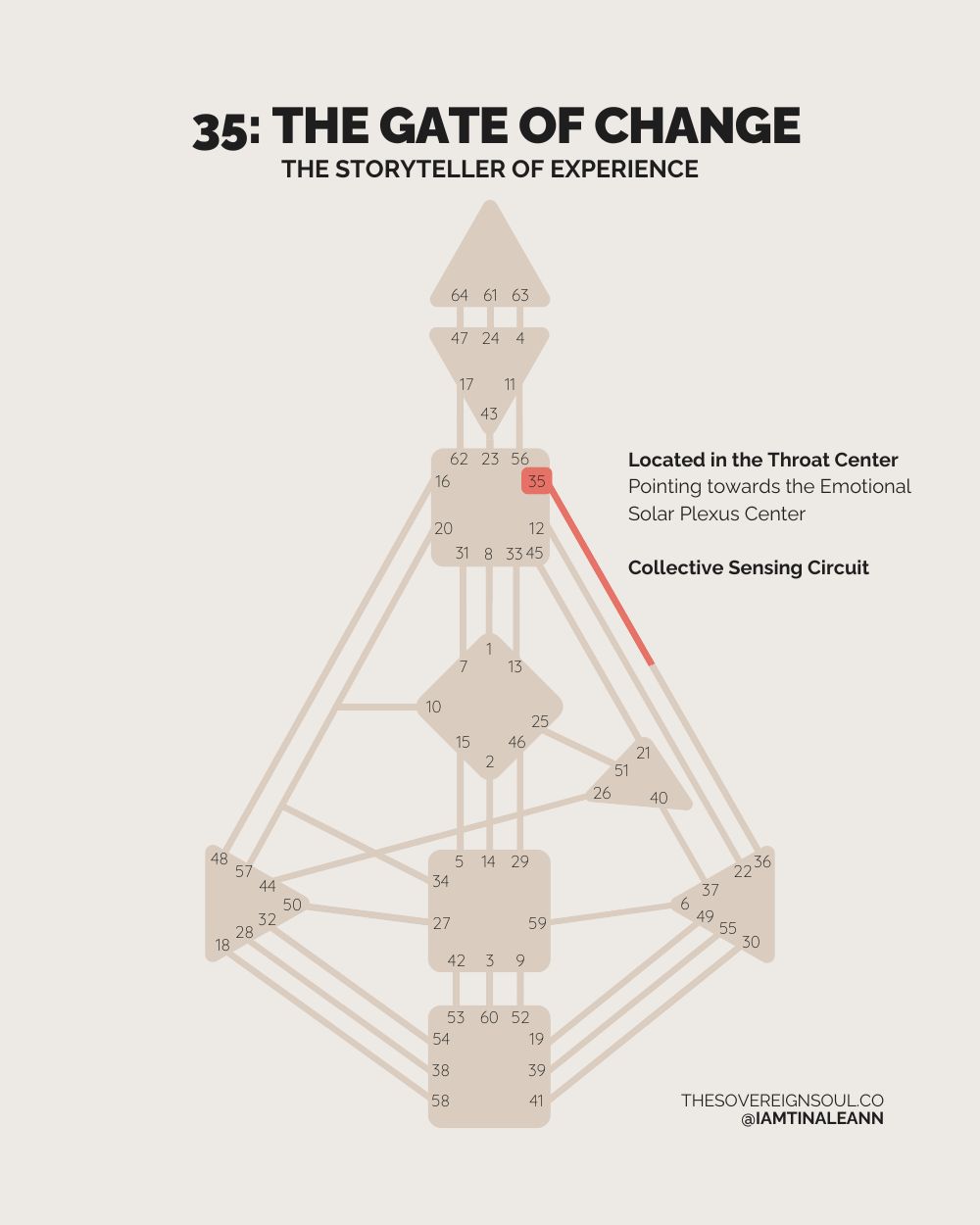Gate 35 in Human Design: The Gate of Change – The Storyteller of Experience
Do you feel a constant pull toward new experiences, change, and adventure? Do you thrive when life is unpredictable, full of learning, and rich with transformation?
If so, you might be experiencing the energy of Gate 35 – The Gate of Change in Human Design.
This gate is all about seeking new experiences, learning through action, and then sharing wisdom with others. People with Gate 35 have an innate desire for variety and exploration, often feeling restless when life becomes too routine. Their challenge is learning to embrace change with awareness rather than chasing it out of boredom.
Gate 35 is located in the Throat Center, which governs communication, manifestation, and self-expression.
This gate is part of the 36-35 Channel (The Channel of Transience) when connected to Gate 36 (The Gate of Crisis) in the Solar Plexus Center. Together, these gates create a hunger for experience and transformation, where Gate 36 brings emotional intensity, and Gate 35 brings the desire to move forward and share wisdom from those experiences.
Key Themes of Gate 35:
✅ A deep need for change and variety – Preferring new experiences over repetition.
✅ Learning through experience – Gaining wisdom by doing, not just thinking.
✅ A powerful storytelling ability – Sharing insights from past adventures.
✅ The challenge of seeking vs. running – Embracing change with awareness, rather than chasing it for distraction.
Gate 35 is part of the Collective Sensing Circuit, meaning its energy is designed to process experiences and share their wisdom with the world.
The Energy of Gate 35: The Thirst for Experience & Change
1. The Drive for New Experiences
Gate 35 is known as The Gate of Change because it constantly seeks new adventures, insights, and ways of seeing the world.
People with this energy often:
🔹 Thrive on variety, learning, and exploration.
🔹 Feel restless when life becomes routine or predictable.
🔹 Have a natural curiosity about different cultures, philosophies, and ways of living.
🔹 Love trying new things, from travel to relationships to creative projects.
✨ Ask yourself: Am I embracing meaningful change, or am I chasing newness just to escape boredom?
2. The Gift of Wisdom Through Experience
Unlike logical thinkers who learn by analyzing, people with Gate 35 learn by living.
🔥 They don’t just talk about things—they experience them firsthand.
🔥 Every challenge, mistake, or adventure becomes a lesson.
🔥 They are natural teachers, coaches, and storytellers who share wisdom from life’s ups and downs.
Because of this, people with Gate 35 often find themselves drawn to teaching, writing, speaking, coaching, or guiding others through change.
✨ Ask yourself: Am I sharing the wisdom from my experiences, or am I constantly moving on without reflection?
3. The Challenge of Restlessness & Boredom
Because Gate 35 thrives on newness and excitement, it can sometimes lead to:
❌ Jumping from one thing to another without finishing anything.
❌ Feeling unsatisfied, always chasing the “next big thing.”
❌ Avoiding deep commitment because it feels restrictive.
❌ Burning out from constant movement and change.
💡 The key to mastering Gate 35 is balancing the desire for new experiences with the wisdom of stillness and reflection.
✨ Ask yourself: Am I embracing change with purpose, or am I running from discomfort?
How to Work with Gate 35 Energy
💡 Follow Your Desire for New Experiences – You are meant to explore life fully, so honor your need for variety and adventure.
💡 Take Time to Reflect on What You’ve Learned – Instead of jumping to the next thing, pause and integrate the wisdom you’ve gained.
💡 Share Your Stories – Your experiences hold valuable lessons for others—whether through speaking, writing, or creative expression.
💡 Commit to Growth, Not Just Change – Seek transformation that deepens your understanding, rather than just newness for the sake of it.
💡 Balance Movement with Stillness – Learning when to embrace change and when to stay present will create greater fulfillment.
The Gift of Gate 35
Gate 35 carries the energy of change, growth, and storytelling.
It teaches us that:
✅ Life is meant to be explored—embrace the adventure.
✅ Wisdom comes through experience—reflect and share your insights.
✅ Newness is exciting, but meaning comes from integration.
✅ Your stories have the power to inspire transformation in others.
If you have this gate, your ability to embrace change, seek adventure, and share your insights is a gift. Honor your love for new experiences, but also allow yourself time to process and integrate—because your wisdom is meant to be shared.
So, the question is: Are you embracing change with awareness, or are you chasing excitement just to escape discomfort?
Feeling this energy? Drop a comment and share how Gate 35 shows up in your life!








